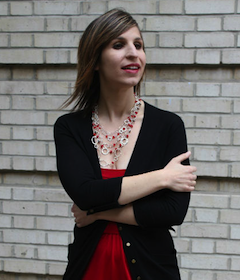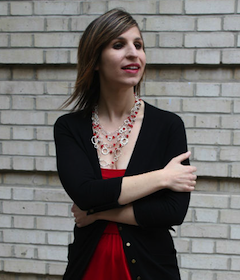
A recital by mezzo-soprano Laurie Rubin is more than just a musical performance. Not only does she demonstrate her considerable musical talents by singing music from composers as disparate as Gabriel Fauré, Jean Sibelius, Richard Rodgers, and Leonard Cohen; she also gives a heart-warming, inspiring, and very personal account of her experiences as a child and her career as an opera singer who happens to be blind. (See a recent Music News item.)
Last Monday, Rubin opened the 10th season of Music at Meyer, the concert series at Temple Emanu-El in San Francisco. Introduced by special guest host Frederica von Stade (who performed during the very first Music at Meyer recital, 10 years ago) and accompanied by her life partner, Jennifer Taira, on piano, Rubin sang a program of art songs, show tunes, and original compositions as part of a national tour of recitals and book readings to promote her recently published memoir, Do You Dream in Color? Insights From a Girl Without Sight.
In the book she describes how she grew up in California to affluent, loving parents who support her and encourage her to pursue her every dream. Blind since birth, she was often told that she would likely never have a real job, live independently, or find romance. With her boundless optimism and the determination to never let herself be defined by anyone else, she has proven all the naysayers wrong — and then some.
This message lies at the heart of her recital, delivered in unpretentious, chatty, and often funny introductions full of personal anecdotes, like the one about going to Hebrew School and choosing Barbra Streisand as her heroine (instead of, for instance, Golda Meir or a biblical female character); or a story about her guide dog, Mark, and crossing 72nd Street and Broadway in New York for the first time — which nicely segued into You’ll Never Walk Alone by Rodgers and Hammerstein.
Laurie Rubin is an entertainer at heart. … She is also a great singer who effortlessly moves through different musical styles and languages.
Laurie Rubin is an entertainer at heart. She has an easy rapport with the audience as well as a charming stage presence and delivery. Her journey to prove herself as a “normal” person in search of a life and career as a performer has eventually led her to embrace her blindness as something that makes her unique. Of course, it doesn’t hurt that she is also a great singer who effortlessly moves through different musical styles and languages. Gabriel Fauré’s compositions Les Berceaux and En Sourdine brought out the warmth of her low register. Her sense of drama in Flickan kom ifran sin alsklings mote, by Jean Sibelius, about a young woman who, after a number of romantic encounters, finds out that her lover is cheating on her, is heart-rending, though Rubin doesn’t reach for that emotional depth in every part of her performance.
The two original pieces on the program were probably the best summary of Rubin as an artist and a person. One was the cantata-like Do You Dream in Color?, by composer Bruce Adolphe, based on a poem by Rubin herself in which she talks about putting on her own makeup, designing jewelry, and dealing with other people’s fear of blindness. Not only did Adolphe commission this poem from Rubin, he also wrote music that allows her to show the entire range of her vocal goods. The other, more “poppy” original composition is The Girl I Am, with lyrics by Rubin and music by Jennifer Taira, which deals with Rubin’s changing self-image and gradual acceptance of the girl she is.
As a postintermission surprise (or early encore), Rubin and her friend and mentor Frederica von Stade performed Duetto buffo di due gatti, or Cat Duet, attributed to Rossini, but actually compiled by English composer Robert Lucas Pearsall from Rossini’s music for his opera Otello (1816).

